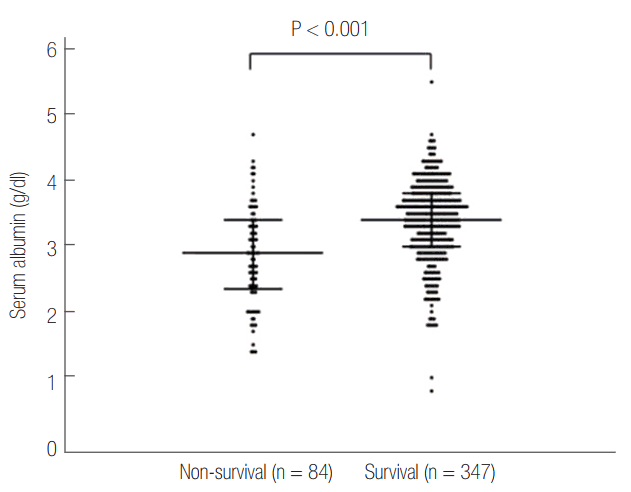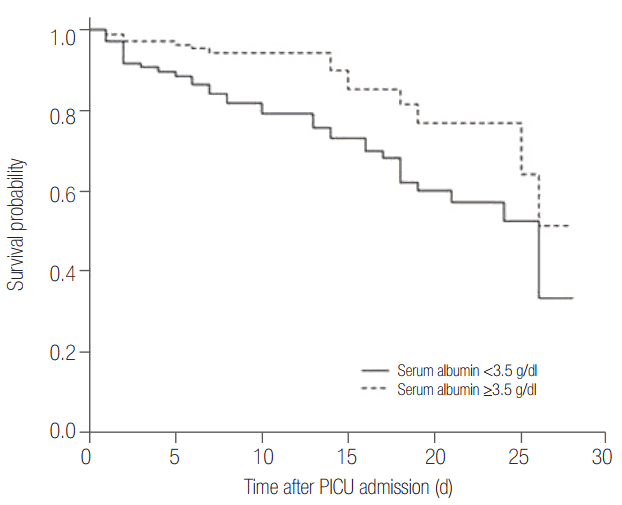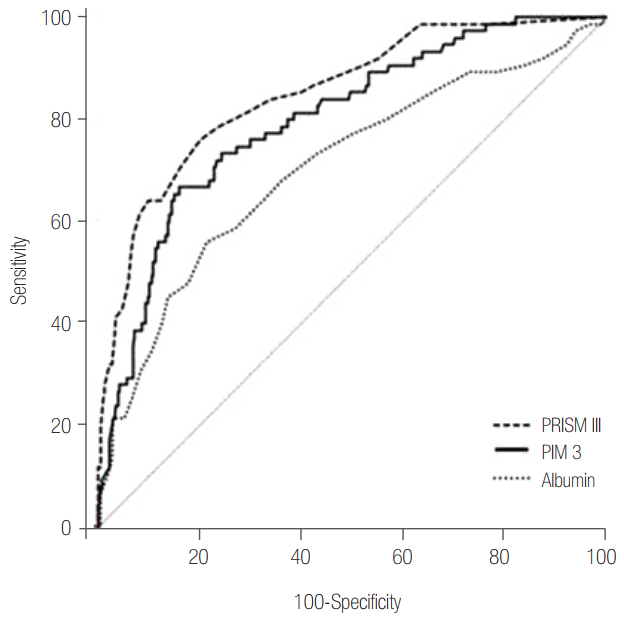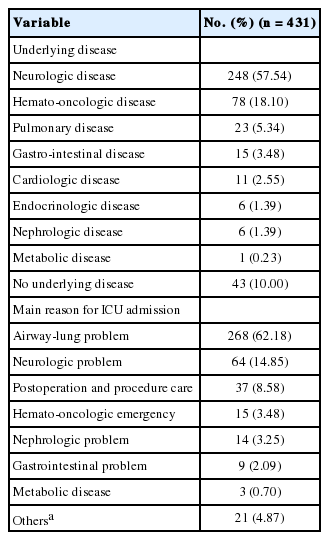Serum Albumin as a Biomarker of Poor Prognosis in the Pediatric Patients in Intensive Care Unit
Article information
Abstract
Background
Serum albumin as an indicator of the disease severity and mortality is suggested in adult patients, but its role in pediatric patients has not been established. The objectives of this study are to investigate the albumin level as a biomarker of poor prognosis and to compare it with other mortality predictive indices in children in intensive care unit (ICU).
Methods
Medical records of 431 children admitted to the ICU at Severance Hospital from January 1, 2012 to December 31, 2015 were retrospectively analyzed. Children who expired within 24 hours after ICU admission, children with hepatic or renal failure, and those who received albumin replacement before ICU admission were excluded.
Results
The children with hypoalbuminemia had higher 28-day mortality rate (24.60% vs. 9.28%, P < 0.001), Pediatric Index of Mortality (PIM) 3 score (9.23 vs. 8.36, P < 0.001), Pediatric Risk of Mortality (PRISM) III score (7.0 vs. 5.0, P < 0.001), incidence of septic shock (12% vs. 3%, P < 0.001), C-reactive protein (33.0 mg/L vs. 5.8 mg/L, P < 0.001), delta neutrophil index (2.0% vs. 0.6%, P < 0.001), lactate level (1.6 mmol/L vs. 1.2 mmol/L, P < 0.001) and lower platelet level (206,000/μl vs. 341,000/μl, P < 0.001) compared to the children with normal albumin level. PIM 3 (r = 0.219, P < 0.001) and PRISM III (r = 0.375, P < 0.001) were negatively correlated with serum albumin level, respectively.
Conclusions
Our results highlight that hypoalbuminemia can be a biomarker of poor prognosis including mortality in the children in ICU.
Introduction
Predicting the prognosis of patients in intensive care unit (ICU) is important for evaluating the quality of ICU, and making decisions regarding further management [1]. The accurate methods of predicting outcomes of patients have been needed, therefore many scoring systems for predicting prognosis including mortality of patients have been proposed. However, predicting the prognosis of critically ill patients whose condition fluctuates every other moments is challenging. Recently developed assessments based on physiologic variables have limitations due to requiring many variables which are not collected for all patients admitted to ICU [1]. Therefore, it is necessary to identify noninvasive, easy means to predict the prognosis of the patients in ICU, especially for pediatric patients.
The critical condition of patients admitted to the ICU is vulnerable to oxidative stresses caused by reactive oxygen species which result in injuries to cells and tissues and activating extracellular antioxidant defense network consecutively [2,3]. There are many antioxidants in extracellular fluids including albumin, which is known as one of the most potent antioxidants [4,5].
Therefore, serum albumin as an indicator of the disease severity and the mortality is suggested and studied in adult patients [6,7] and it has been found that the decrease in serum albumin concentration significantly raises the mortality [8]. Hypoalbuminemia (serum albumin <3.5 g/dl) is frequently observed in patients admitted to the pediatric intensive care unit (PICU) [2], but its role in pediatric patients has not been established.
In this study, we evaluated the value of serum albumin level at PICU admission as a biomarker of poor prognosis including mortality in critically ill children regardless of underlying etiology and compared serum albumin level with other mortality predictive indices which are universally used in many PICU settings.
Materials and Methods
1) Study population
We enrolled 431 pediatric patients admitted to the ICU in Severance Hospital with the exception of cardiology and surgical unit where patients who need cardiologic surgeries admit separately between January 1, 2012 and December 31, 2015. Patients were over 1 month and under 18 years of age. Patients who expired within 24 hours after ICU admission, had hepatic or renal failure, or received albumin replacement before ICU admission were excluded. We defined infection by the presence of a pathogen-proven infection (positive culture, tissue stain, or polymerase chain reaction test) or a clinical syndrome associated with a high probability of infection, such as positive findings on clinical examination, imaging, or laboratory tests (e.g., white blood cells in a normally sterile body fluid, perforated viscus, chest radiograph consistent with pneumonia, petechial or purpuric rash, or purpura fulminans) [9]. This study was approved by the Institutional Review Board of Severance Hospital (protocol No. 4-2013-0207). The informed consent was waived.
2) Data collection
All data were collected and analyzed retrospectively. Initial blood sample results which obtained at the time of ICU admission were analyzed. Hypoalbuminemia was defined by serum albumin concentration <3.5 g/dl. Age, sex, nutritional status, mortality, length of ICU stay, reason for admission, sepsis, septic shock, requirement for respiration support in the first 1 hour of ICU, and requirement for mechanical ventilation within 24 hours of ICU admission were collected.
3) Statistical analysis
Baseline characteristics of patients were compared using independent two sample t-test and Mann-Whitney U-test, as appropriate. Groups were compared by the chi-square test for categorical variables.
Univariable and multivariable logistic regression model were used to identify independent predictors of mortality and to examine the relation between serum albumin and mortality. The correlation between serum albumin and other mortality predictive indices was assessed using Spearman’s method. Survival curves were determined using Kaplan-Meier method. Statistical analyses were performed with IBM SPSS version 23.0 (IBM Corp., Armonk, NY, USA).
The predictive values of serum albumin, Pediatric Index of Mortality (PIM) 3 score, and Pediatric Risk of Mortality (PRISM) III score were compared by calculating the area under the receiver operating characteristic curve (AUC). Receiver operating characteristic curve for discrimination and comparisons of AUCs between other mortality predictive indices and albumin incorporated models (PIM 3 with albumin, and PRISM III with albumin) were used by SAS version 9.3 (SAS Institute, Cary, NC, USA).
Net reclassification improvement (NRI) and integrated discrimination improvement (IDI) were performed to assess improvement in mortality prediction after incorporating albumin to PIM 3, PRISM III by using R software version 3.0.1 (R Foundation for Statistical Computing, Vienna, Austria). A P < 0.05 was considered statistically significant.
Results
1) Patients’ characteristics
A total of 431 pediatric patients had diverse underlying diseases and reasons for ICU admission (Table 1). The most common underlying disease was neurologic disease (248 patients, 58%), and others were hemato-oncologic disease (78 patients, 18%), pulmonary disease (23 patients, 5%), gastro-intestinal disease (15 patients, 3%), cardiologic disease (11 patients, 3%), endocrinologic disease (six patients, 1%), nephrologic disease (six patients, 1%), and so on. The most common reason for ICU admission is airway-lung problem (268 patients, 62%) and other reasons were neurologic problem (64 patients, 15%), postoperation or procedure care (37 patients, 9%), hemato-oncologic problem (15 patients, 3%), nephrologic problem (14 patients, 3%), gastrointestinal problem (nine patients, 2%), metabolic diseases (three patients, 1%) and others (21 patients, 5%) sequentially. The patients’ baseline characteristics are presented in Table 2. The median age of patients was 3.1 years, and the number of male patients was 261 (60.6%). The incidence of hypoalbuminemia was 55.0% (237/431).
2) Clinical characteristics by serum albumin level
Patients were divided into the normoalbuminemia (n = 194) and the hypoalbuminemia (n = 237) group on the basis of serum albumin level (Table 3). No statistically significant difference was observed in the age, sex, the nutritional status, the length of ICU stay, and the main reason for ICU admission between two groups.
The patients with hypoalbuminemia had higher delta neutrophil index (2.0% vs. 0.6%, P < 0.001), C-reactive protein (33.0 mg/L vs. 5.8 mg/L, P < 0.001), lactate level (1.6 mmol/L vs. 1.2 mmol/L, P < 0.001), PIM 3 (9.23 vs. 8.36, P < 0.001), PRISM III (7.0 vs. 5.0, P < 0.001), 28-day mortality rate (24.60% vs. 9.28%, P < 0.001), incidence of septic shock (11.8% vs. 2.6%, P < 0.001), and lower hemoglobin level (10.2 g/dl vs. 11.0 g/dl, P < 0.001) and platelet level (206,000/μl vs. 341,000/μl, P < 0.001) compared to the normoalbuminemia group (Table 3).
3) Clinical characteristics in infection and non-infection group by serum albumin level
Patients were divided into infection group (n = 299) and non-infection group (n = 132) as we defined in the Materials and Methods. No statistically significant difference was observed in the age, sex, the nutritional status, and the length of ICU stay in both infection and non-infection group (Supplementary Tables 1 and 2). The patients with hypoalbuminemia had higher delta neutrophil index, C-reactive protein, lactate level, PIM 3, PRISM III, 28-day mortality rate, incidence of septic shock, and lower hemoglobin level and platelet level compared to the normoalbuminemia patients in both infection and non-infection group (Supplementary Tables 1 and 2). This is consistent with the result of comparison of clinical characteristics in the total group by serum albumin level (Table 3).
4) Clinical characteristics in infant and the other group by serum albumin level
Patients were divided by the age, infant group (n = 96) and the other group (age, ≥1 year; n = 335). No statistically significant difference was observed in the age, sex, the nutritional status, and the length of ICU stay in both age group (Supplementary Tables 3 and 4). The patients with hypoalbuminemia had higher delta neutrophil index, C-reactive protein, lactate level, PIM 3, PRISM III, 28-day mortality rate, incidence of septic shock, and lower platelet level compared to the normoalbuminemia patients in both age groups as others (Supplementary Tables 3 and 4). Hemoglobin level was statistically significant in patients who were above 1 year old, but not for infant group.
5) Serial serum albumin levels for the first 4 days in ICU
We compared serial serum albumin levels for the first 4 days in ICU between survivors and non-survivors in hypoalbuminemia and normoalbuminemia group separately (Figure 1). Serum albumin level in survivors remained higher than non-survivors in both groups. Serum albumin level of non-survivors was below 3.5 g/dl in the second, third, and fourth day in ICU in both groups.
6) Albumin as a predictor of mortality in PICU patients
Serum albumin level in the survival group is higher than that in the non-survival group (3.4 g/dl [interquartile range, 3 to 3.8 g/dl] vs. 2.9 g/dl [interquartile range, 2.3 to 3.4 g/dl], P < 0.001) (Figure 2). Figure 3 shows survival curves according to albumin level and it shows that the normoalbuminemia group has higher survival probability than the hypoalbuminemia group. In the univariable analyses, nine variables including albumin were correlated with the mortality (P < 0.001) (Table 4).

Albumin level between non-survival and survival group. Serum albumin level in the survival group was higher than the non-survival group (3.4 g/dl [interquartile range, 3 to 3.8 g/dl] vs. 2.9 g/dl [interquartile range, 2.3 to 3.4 g/dl], P < 0.001). The error bar represents the median and interquartile range for each group.

Survival probability according to albumin level. Kaplan-Meier survival estimate for patients according to serum albumin level (albumin <3.5 g/dl vs. albumin ≥3.5 g/dl). This survival curve showed that the hypoalbuminemia group had lower survival probability than the normoalbuminemia group. PICU: pediatric intensive care unit.
We also considered the relationship between serum albumin at admission and pre-existing mortality prediction models used in ICU. Even though the correlation coefficients were low, each model was significantly correlated with serum albumin (Supplementary Table 5). The AUC was 0.702 for serum albumin, 0.802 for PIM 3, and 0.850 for PRISM III score (Figure 4, Supplementary Table 5).

Receiver operating characteristic curves for mortality between albumin and intensive care unit mortality scoring systems. Area under the receiver operating characteristic curve: PRISM III, 0.850 (95% CI, 0.801 to 0.899); PIM 3, 0.802 (95% CI, 0.747 to 0.858); albumin, 0.702 (95% CI, 0.633 to 0.772). PRISM: Pediatric Risk of Mortality; PIM: Pediatric Index of Mortality; CI: confidence interval.
There was no improvement of predicting mortality in the corporation of serum albumin to pre-existing mortality prediction models; however, incorporating albumin to pre-existing mortality prediction models showed a tendency to be more predictive of mortality than PIM 3, PRISM III alone (Supplementary Table 6). The PIM 3 with serum albumin provided an NRI of 21.0% (P = 0.136) and IDI of 4.3% (P = 0.158), and the PRISM III with serum albumin yielded an NRI of 24.5% (P = 0.388) and IDI of 2.1% (P = 0.416) (Supplementary Table 7).
Discussion
We showed that serum albumin concentration at ICU admission was higher in survivors compared with nonsurvivors in children. Patients with hypoalbuminemia at ICU admission had higher mortality rate. In addition, serum albumin concentration was negatively correlated with pre-existing mortality prediction models including PIM 3 and PRISM III.
The prevalence of hypoalbuminemia in critically ill children is about 33%–57% from previous studies [10-12]. Hypoalbuminemia has long been a predictor of poor outcome, such as mortality, morbidity, and prolonged ICU and hospital stay [5]. There are many studies that low serum albumin concentration reflects disease severity and prognosis in critically ill adult patients [13-16]. Regarding pediatric patients, studies on this issue were limited to only some specific circumstances, such as cardiac surgery children, pediatric renal transplant recipients, showing that hypoalbuminemia is a risk factor for cardiac surgery and graft failure [17,18]. Serum albumin concentration as a predictor of clinical outcomes of critically ill children in general circumstances is so far inconclusive [10,11].
Albumin plays important role as an osmotic pressure determinant balancing between intravascular and interstitial space, a non-specific carrier protein, and an antioxidant by scavenging of oxygen free radicals to protect against oxidant injuries [19,20]. The important determinants of serum albumin concentration in critically ill patients are synthetic rate and leakage of albumin to interstitial space from intravascular space [19,21]. As the clinical course of critically ill patients progresses, the distribution of albumin from intravascular to interstitial spaces occurs resulting from increases of capillary leakage by the response of systemic inflammation [20]. Since the leakage of albumin into the extravascular spaces is related to the degree of systemic inflammation [22], the development of hypoalbuminemia is liable to be seen in patients with poor clinical status. Owing to potency of albumin as an antioxidant agent, in addition to this kinetic and dynamic alteration of albumin in critically ill patients, hypoalbuminemia is associated with poor clinical outcomes such as mortality, morbidity and prolonged hospital stay in critically ill patients [5,23].
Mortality is the worst outcome of clinical management in ICU setting. Early recognition of probability of mortality in critically ill patients can help to make prompt and precise decision to give the best treatment to patients by risk stratification. Therefore, predicting mortality risk is a major concern of ICU care. Several predictive indices have been suggested to predict the risk of death in critically ill children of ICU, but some predictive indices are too complicated demanding too much information to calculate the mortality risk. As a result, there has been an increasing need to establish a clinical value to use in children in ICU easily. Several biomarkers such as delta neutrophil index, C-reactive protein, and thrombocytopenia have been suggested as predictors of poor prognosis including mortality in children in ICU [24-26].
We designed this study to investigate whether hypoalbuminemia at admission can predict prognosis including mortality in pediatric patients in ICU. Comparing hypoalbuminemia group of patients and normoalbuminemia group of patients, we showed that hypoalbuminemia at admission to ICU was associated with the higher mortality, regardless of the underlying disease. Furthermore, even though there was no statistical significance, incorporation of serum albumin at admission to other predictive indices showed a tendency to be more predictive in this study. This shows that serum albumin concentration, which could be obtained through a simple, sensitive, low cost assay, could help assessing the current status and predicting outcomes of critically ill pediatric patients in ICU.
There are some limitations in the current study. First, this study was limited to the single center using the data collected retrospectively. Since serum albumin level below 2.5 g/dl were replaced and above 2.5 g/dl were not in this retrospective data, this study was not able to evaluate the effectiveness of albumin replacement. Therefore, further studies might be needed in a multicenter setting using prospective data.
In conclusion, hypoalbuminemia at admission was associated with higher mortality in children in ICU. We suggest that hypoalbuminemia at admission could be used as a biomarker of poor prognosis of children in ICU, regardless of underlying etiology.
Notes
No potential conflict of interest relevant to this article was reported.
Supplementary Materials
The online-only Supplement data are available with this article online: https://doi.org/10.4266/kjccm.2017.00437.





